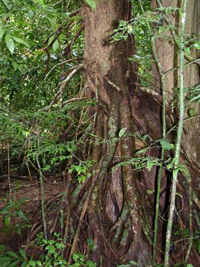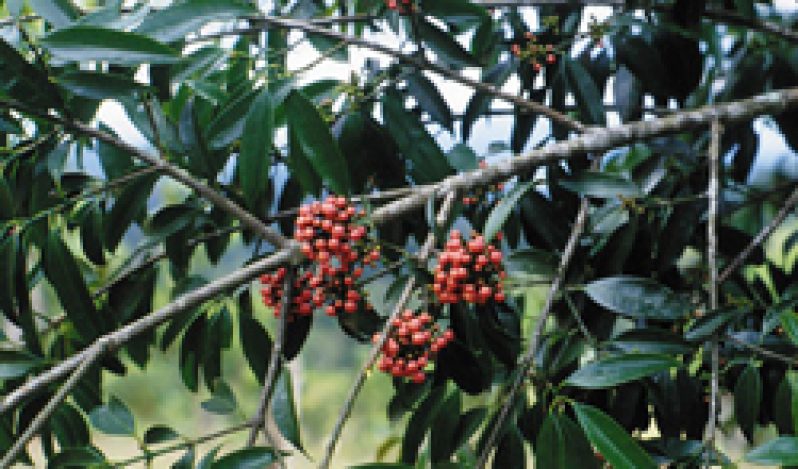THE Symphonia globulifera, known locally as ‘Manni’, is one of the lesser known but very useful flora of the rainforests of Guyana, a species characterized by its short, stilt-like roots at its lower end, and exploited commercially as a source of timber.
 The Manni is also native to other rainforests, from Guinea-Bissau, to Sierra Leone, the Cameroons, Tanzania and Angola in Africa, to those of South and Central America.
The Manni is also native to other rainforests, from Guinea-Bissau, to Sierra Leone, the Cameroons, Tanzania and Angola in Africa, to those of South and Central America.
A tall tree, reaching heights of up to 40m (or 130ft), its trunk is invariably long, straight, and cylindrical, while its bark is furrowed, and its crown dense and narrow.
The tree’s bark contains a yellow resin, which is strongly adhesive and water-resistant, and reputed to be very useful in treating ulcers. The resin is also used for making candles and torches and caulking boats.
The fruit of the Manni is first green, then red, then brown; is almost wart-like in appearance; and it is edible.
Scientists say the Manni has a long history, going back some 45 million years to Africa. It is unusual among tropical trees, in that it has a well-studied fossil record, partly because the oil industry uses its distinctive pollen fossils as a stratigraphic tool in determining antiquity.
Deposits of fossil pollen seem to suggest that out of the blue some 15 to 18 million years ago, the Manni appeared in South America, and then in Central America.
But unlike the Kapok (silk cotton), a tropical tree with a similar distribution pattern, the Manni isn’t well-suited to travelling across oceans, as its seeds tend to dry out easily, and are saltwater intolerant.
So, eternally puzzled as to how the tree actually reached South America from Africa, scientists have taken to speculating that most likely the seeds hitched a ride on rafts of vegetation, as did monkeys at the time. Whole trunks, which can send out shoots when they reach a suitable resting place, may have made the journey in that manner. Scientists also surmise that because Central and South America had no land connection at the time, the Manni must have colonized each location separately.
Whole trunks, which can send out shoots when they reach a suitable resting place, may have made the journey in that manner. Scientists also surmise that because Central and South America had no land connection at the time, the Manni must have colonized each location separately.
But once the Manni reached its new home, it spread throughout the Central and South American rainforests.
The Manni is said to thrive well in swamps and marshy areas, especially by the sides of lagoons, creeks and rivers, all conditions which exist in certain low-lying coastal areas of Guyana, particularly between the Barima and Pomeroon Rivers and their tributaries in the Barima/Waini areas of Region One. Many of the dugout canoes used by hinterland dwellers in Guyana are made from hollowed-out Manni trees.
Here in Guyana, the Manni is harvested, and its wood can be, and is used as a substitute for Mahogany. Noted for its resistance to insect and fungal attack, the wood of the Manni tree is put to a number of uses, such as boat building, making boxes and crates, cabinetry, domestic flooring and household furniture, interior trim, marine construction, parquet flooring, and pulp and paper products.
It can also be used to make household utensils and paddles.



.jpg)









